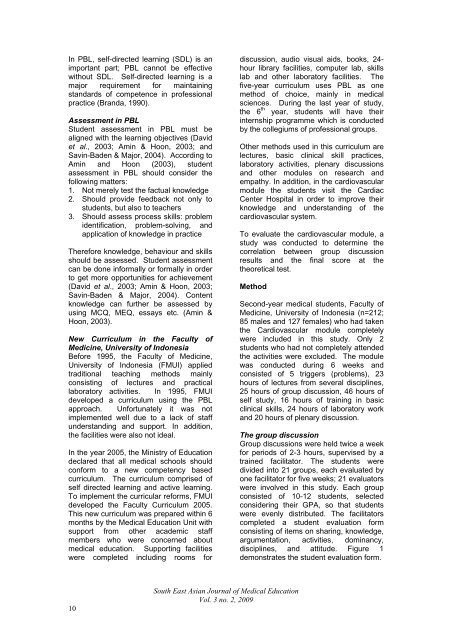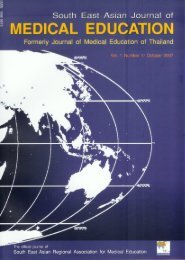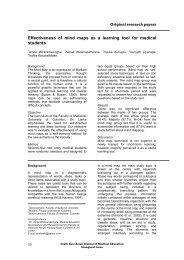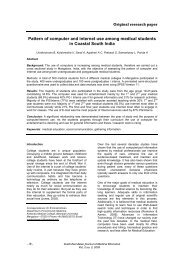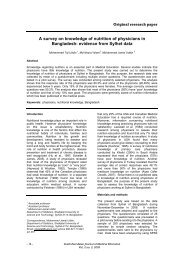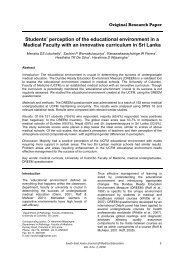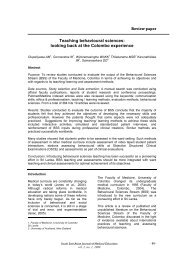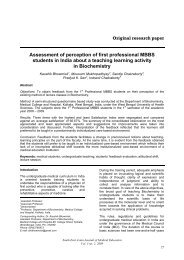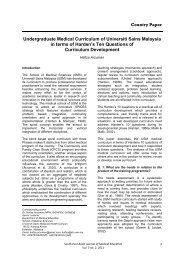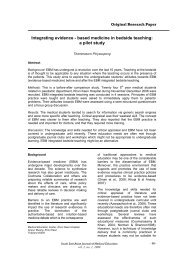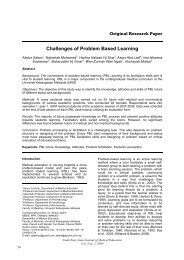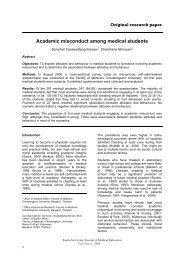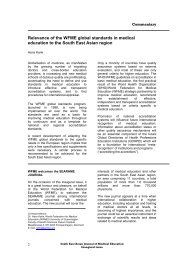Correlation between group discussion and examination result in ...
Correlation between group discussion and examination result in ...
Correlation between group discussion and examination result in ...
You also want an ePaper? Increase the reach of your titles
YUMPU automatically turns print PDFs into web optimized ePapers that Google loves.
In PBL, self-directed learn<strong>in</strong>g (SDL) is an<br />
important part; PBL cannot be effective<br />
without SDL. Self-directed learn<strong>in</strong>g is a<br />
major requirement for ma<strong>in</strong>ta<strong>in</strong><strong>in</strong>g<br />
st<strong>and</strong>ards of competence <strong>in</strong> professional<br />
practice (Br<strong>and</strong>a, 1990).<br />
Assessment <strong>in</strong> PBL<br />
Student assessment <strong>in</strong> PBL must be<br />
aligned with the learn<strong>in</strong>g objectives (David<br />
et al., 2003; Am<strong>in</strong> & Hoon, 2003; <strong>and</strong><br />
Sav<strong>in</strong>-Baden & Major, 2004). Accord<strong>in</strong>g to<br />
Am<strong>in</strong> <strong>and</strong> Hoon (2003), student<br />
assessment <strong>in</strong> PBL should consider the<br />
follow<strong>in</strong>g matters:<br />
1. Not merely test the factual knowledge<br />
2. Should provide feedback not only to<br />
students, but also to teachers<br />
3. Should assess process skills: problem<br />
identification, problem-solv<strong>in</strong>g, <strong>and</strong><br />
application of knowledge <strong>in</strong> practice<br />
Therefore knowledge, behaviour <strong>and</strong> skills<br />
should be assessed. Student assessment<br />
can be done <strong>in</strong>formally or formally <strong>in</strong> order<br />
to get more opportunities for achievement<br />
(David et al., 2003; Am<strong>in</strong> & Hoon, 2003;<br />
Sav<strong>in</strong>-Baden & Major, 2004). Content<br />
knowledge can further be assessed by<br />
us<strong>in</strong>g MCQ, MEQ, essays etc. (Am<strong>in</strong> &<br />
Hoon, 2003).<br />
New Curriculum <strong>in</strong> the Faculty of<br />
Medic<strong>in</strong>e, University of Indonesia<br />
Before 1995, the Faculty of Medic<strong>in</strong>e,<br />
University of Indonesia (FMUI) applied<br />
traditional teach<strong>in</strong>g methods ma<strong>in</strong>ly<br />
consist<strong>in</strong>g of lectures <strong>and</strong> practical<br />
laboratory activities. In 1995, FMUI<br />
developed a curriculum us<strong>in</strong>g the PBL<br />
approach. Unfortunately it was not<br />
implemented well due to a lack of staff<br />
underst<strong>and</strong><strong>in</strong>g <strong>and</strong> support. In addition,<br />
the facilities were also not ideal.<br />
In the year 2005, the M<strong>in</strong>istry of Education<br />
declared that all medical schools should<br />
conform to a new competency based<br />
curriculum. The curriculum comprised of<br />
self directed learn<strong>in</strong>g <strong>and</strong> active learn<strong>in</strong>g.<br />
To implement the curricular reforms, FMUI<br />
developed the Faculty Curriculum 2005.<br />
This new curriculum was prepared with<strong>in</strong> 6<br />
months by the Medical Education Unit with<br />
support from other academic staff<br />
members who were concerned about<br />
medical education. Support<strong>in</strong>g facilities<br />
were completed <strong>in</strong>clud<strong>in</strong>g rooms for<br />
<strong>discussion</strong>, audio visual aids, books, 24-<br />
hour library facilities, computer lab, skills<br />
lab <strong>and</strong> other laboratory facilities. The<br />
five-year curriculum uses PBL as one<br />
method of choice, ma<strong>in</strong>ly <strong>in</strong> medical<br />
sciences. Dur<strong>in</strong>g the last year of study,<br />
the 6 th year, students will have their<br />
<strong>in</strong>ternship programme which is conducted<br />
by the collegiums of professional <strong>group</strong>s.<br />
Other methods used <strong>in</strong> this curriculum are<br />
lectures, basic cl<strong>in</strong>ical skill practices,<br />
laboratory activities, plenary <strong>discussion</strong>s<br />
<strong>and</strong> other modules on research <strong>and</strong><br />
empathy. In addition, <strong>in</strong> the cardiovascular<br />
module the students visit the Cardiac<br />
Center Hospital <strong>in</strong> order to improve their<br />
knowledge <strong>and</strong> underst<strong>and</strong><strong>in</strong>g of the<br />
cardiovascular system.<br />
To evaluate the cardiovascular module, a<br />
study was conducted to determ<strong>in</strong>e the<br />
correlation <strong>between</strong> <strong>group</strong> <strong>discussion</strong><br />
<strong>result</strong>s <strong>and</strong> the f<strong>in</strong>al score at the<br />
theoretical test.<br />
Method<br />
Second-year medical students, Faculty of<br />
Medic<strong>in</strong>e, University of Indonesia (n=212;<br />
85 males <strong>and</strong> 127 females) who had taken<br />
the Cardiovascular module completely<br />
were <strong>in</strong>cluded <strong>in</strong> this study. Only 2<br />
students who had not completely attended<br />
the activities were excluded. The module<br />
was conducted dur<strong>in</strong>g 6 weeks <strong>and</strong><br />
consisted of 5 triggers (problems), 23<br />
hours of lectures from several discipl<strong>in</strong>es,<br />
25 hours of <strong>group</strong> <strong>discussion</strong>, 46 hours of<br />
self study, 16 hours of tra<strong>in</strong><strong>in</strong>g <strong>in</strong> basic<br />
cl<strong>in</strong>ical skills, 24 hours of laboratory work<br />
<strong>and</strong> 20 hours of plenary <strong>discussion</strong>.<br />
The <strong>group</strong> <strong>discussion</strong><br />
Group <strong>discussion</strong>s were held twice a week<br />
for periods of 2-3 hours, supervised by a<br />
tra<strong>in</strong>ed facilitator. The students were<br />
divided <strong>in</strong>to 21 <strong>group</strong>s, each evaluated by<br />
one facilitator for five weeks; 21 evaluators<br />
were <strong>in</strong>volved <strong>in</strong> this study. Each <strong>group</strong><br />
consisted of 10-12 students, selected<br />
consider<strong>in</strong>g their GPA, so that students<br />
were evenly distributed. The facilitators<br />
completed a student evaluation form<br />
consist<strong>in</strong>g of items on shar<strong>in</strong>g, knowledge,<br />
argumentation, activities, dom<strong>in</strong>ancy,<br />
discipl<strong>in</strong>es, <strong>and</strong> attitude. Figure 1<br />
demonstrates the student evaluation form.<br />
10<br />
South East Asian Journal of Medical Education<br />
Vol. 3 no. 2, 2009


